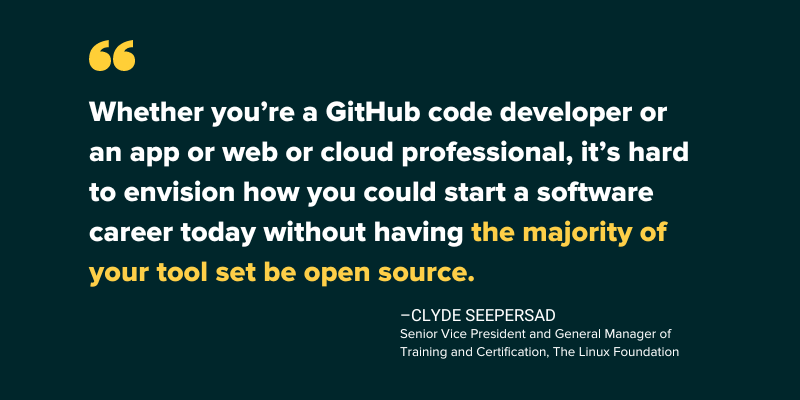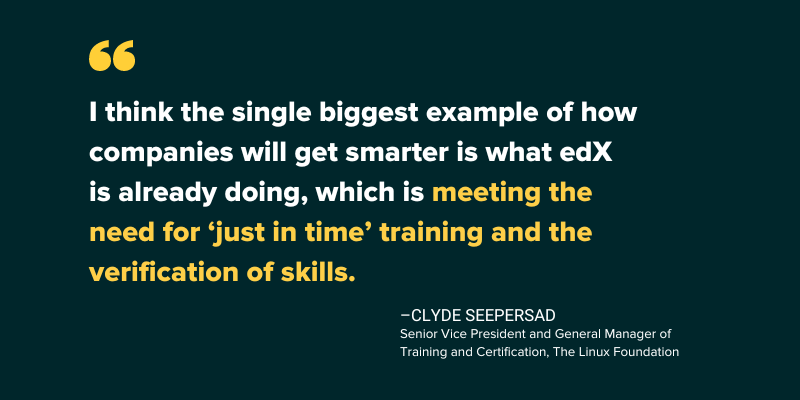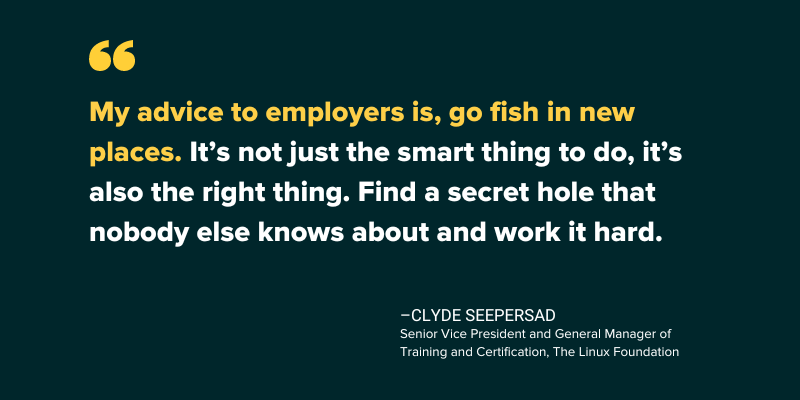What The Linux Foundation Predicts and Advises for Hiring Future Tech Talent Based on 10 Years of Open Source Job Reports
Hear from The Linux Foundation’s Clyde Seepersad as he reflects on a decade of trends in open source hiring, training, and skills development—and what he sees as the future for tech careers.
Over the past quarter of a century, open source technology—software and its source code that can be used, adapted, and shared freely by anyone for any purpose—has grown in popularity across virtually every industry. In the education space, for example, Open edX enables anyone worldwide to create and deliver engaging online educational experiences to learners. In computing, Linux is the open source operating system that powers virtually 100% of cloud computing, all of the world’s supercomputers, most of its internet servers, and billions of mobile devices. Speaking personally, we even used Linux to power many of the research computer systems we built at MIT over the years.
As Clyde Seepersad, senior vice president and general manager of training and certification at The Linux Foundation, explains, open source is not only the foundation for nearly all code today, but also a significant driver of tech jobs in an increasingly competitive marketplace.
“In the early 2000s, companies began having the epiphany that building software on their own is expensive and risky—and buying it from a commercial vendor creates serious issues of vendor lock-in and lack of portability,” Seepersad says. “Once businesses realized that the collaborative development of software is a cheaper, faster, and more secure, responsive, and scalable way to achieve their goals and still build their own products on top of the code, they began embracing the open source development process. But that opened up new challenges in finding and retaining open source talent.”
Earlier this summer, The Linux Foundation in partnership with edX published the 10th Annual Open Source Jobs Report—a comprehensive resource for employers and tech professionals that explores the field’s latest trends in hiring, training, and skills development. I recently sat down with Seepersad to reflect on The Linux Foundation’s first decade of research and findings and predict what the future holds for open source careers.

Ten years of Open Source Jobs Reports—that’s an impressive milestone! Looking back to a decade ago, tell us: Why did The Linux Foundation decide to launch the report, and how has open source evolved in its purpose over the years?
Leading up to our first report in 2012, tech companies were starting to scale out with virtualized computing and use the LAMP (Linux, Apache, MySQL, and PHP) stack of open source technologies to power the first iteration of the commercial web. They were paying for hypervisors and servers but then began wondering: What if we didn’t have to pay for the operating system? So, that’s what propelled this growing guerrilla usage of Linux—and that’s what compelled us to create our first report, because we saw a mismatch in the market between the rate at which people with Linux skills were being sought out and the supply. Flash forward a few years, and open source is a much bigger phenomenon beyond Linux: It’s all of these other interlocking technologies too, like 5G, AI, edge IoT (Internet of Things), and Kubernetes.
Outside of those who really know tech, open source is still generally perceived as an exotic use case—when in reality, 90-plus percent of all code commercially used these days is being developed by the community collaboratively. Whether you’re a GitHub code developer or an app or web or cloud professional, it’s hard to envision how you could start a software career today without having the majority of your tool set be open source.
The growth of open source and how ubiquitous it has become is truly fascinating. As referenced in this year’s report, open source jobs are projected by some to grow as much as 18% through 2026—but according to 93% of the hiring managers surveyed, open source talent remains difficult to find. How do you predict companies will try to be “smarter” about developing and/or acquiring open source talent in the future? And then once they have that talent, what are the best ways they can retain it?
I think the single biggest example of how companies will get smarter is what edX is already doing, which is meeting the need for “just in time” training and the verification of skills. Historically and still today, if you ask a tech hiring manager who they’d like to hire, they go through this flight of fantasy about someone with a college degree, four or more years of experience, and deep technical knowledge.
But Kubernetes, for example, has only been open source for six years, so where will they find that profile? It doesn’t exist. Companies still need to determine if someone has demonstrable technical skills, but they need to shift their recruiting strategy to accept that those skills no longer need to be acquired through a degree or a job. People can train and certify in these skills in other ways and still be productive in their role from day one.
That’s a huge leap for employers to make, but frankly, it’s now a better strategy to hire two entry-level people and invest in their learning versus pay a headhunter to hire one “senior” person who’ll probably leave in 12 months when the next headhunter comes along. Companies are better off developing a pool of tech talent that’s more affordable to acquire early on and having the patience to groom and grow them over time.

According to this year’s report, there continues to be more open source job openings than qualified people to fill them. How do you see certifications in tech skills becoming even more valued and important in the future?
The critical factor here is confidence. With this tsunami of digital badges flooding the internet right now, it can be tricky for an employer to figure out which of these certifications are real and meaningful. So, it’s extremely important to have a trusted third-party institution like edX that’s doing the due diligence to be able to state that Person X completed a program and acquired a set of skills to a high degree of rigor. Companies can have that confidence with edX because edX spends a lot of time and energy researching what the job needs are in the market, curating programs to hit all the requisite skills, and scrutinously verifying that education.
Connected to curating programs that teach those in-demand skills, Introduction to Linux was the first course The Linux Foundation put on the edX platform back in 2014, and today it’s also available in Spanish. Over the last eight years, how have the Foundation’s edX courses been helping tech professionals learn the skills they need, and how do you see these courses continuing to evolve in the future?
Over time at Linux, we’ve realized there are two parallel tracks for putting courses on edX. The first is creating courses on specific technical topics for our “insider” audiences who are already close to technology and know the exact skills or programs they need to learn. The second track is for our ‘newbie’ audiences who don’t really know what to look for, so for those folks, our verified certificate programs curate a whole subset field of knowledge in a very structured and sequenced way.
From my perspective, that’s probably the biggest step forward with 2U’s acquisition of edX last year: more muscle on storytelling, because our newbies need career guidance and motivation to figure out that they, too, can learn tech and have a successful career in it, even if they’re from populations that have been underrepresented in the field up to this point. It’s really possible for almost anyone, because there’s such a talent shortage in tech and that “four or more years of experience” bias has flown out the window.

Speaking of more diversity in the workforce, this year’s report explains how women, people of color, and folks from lower socio-economic backgrounds have historically been underrepresented in tech. As we wrap up our discussion here, one last question: What practices do you believe employers will take on to support all kinds of workers and learners in the future—and how do you see employers benefiting from these investments?
Think of it this way: If you find a place to fish where no one else is fishing, you’re going to catch a lot more fish. In the era of COVID, when it comes to embracing more diversity in tech, the biggest exogenous factor in all of this has been remote work. Companies big and small have realized that people don’t need to physically be in an office every day to be productive and add value. Allowing for remote work releases businesses to go fishing in talent pools that are geographically unbound.
So, my advice to employers is, go fish in new places. It’s not just the smart thing to do, it’s also the right thing. Find a secret hole that nobody else knows about and work it hard—which directly translates to going after underrepresented markets for which the list is long: women, ethnic minorities, LGBTQIA+, overseas, and so forth. It’s the only way you’re going to get staffed.
Related Content: Future of Learning and Work

.png)